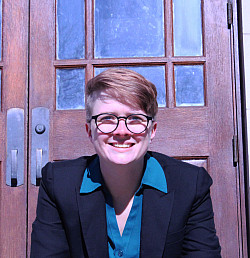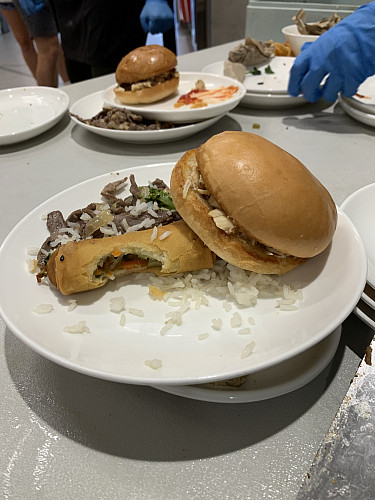First graduate of food studies master’s program reveals scale of food waste
By Kirk Johannesen
May 09, 2023

Kaeley Geschke, who earned a Master of Arts in food studies in December from IU Bloomington, worked in conjunction with IU Dining to conduct her “Weigh the Waste” project at two residence dining halls in the fall. The data, when extrapolated, showed that each person was generating an average of 67 pounds of food waste per semester.
“Students didn’t know how much they were throwing out,” Geschke said.
Brian Gilley, who oversees the food studies program in the College of Arts and Sciences’ Department of Anthropology, said Geschke’s work on food waste is an excellent example of the kinds of projects program leaders want students to do.
“She looked not only at the practical aspects of waste but also added to our knowledge about the ways culture, privilege and other population dynamics impact students’ awareness of food waste, preference and willingness to change habits,” said Gilley, a professor of anthropology.
The program

The master’s program in food studies was in the works for about six years before the first cohort started in the 2021-22 school year. IU has been a leader in food studies for 20 years, Gilley said, and the master’s program was created to meet demand for more educational opportunities in food studies. Such programs were largely in the fields of nutrition and agriculture, but IU added the cultural, historical and social justice component mostly missing from existing programs in the U.S., he said.
Geschke, who earned undergraduate degrees in anthropology and journalism from IU and plans on a career in the restaurant business, said the program appealed to her because it covered a variety of topics, including farming, sustainability and food equity.
The master’s program intends for graduates to become experts in food systems and how they connect to sociological, social, cultural and political systems. The program involves four semesters of classes, an internship and a capstone project.
Geschke finished in three semesters, though. It was during her internship with IU Dining that she decided to do the “Weigh the Waste” project for her capstone.
The project
Ken Field, IU director of residential dining, had conducted a food-waste-weighing project when he was at Northwestern University.
“It informed students on how much food they were wasting; it was very successful and eye-opening for students,” Field said. “When I came to IU, I had the idea to do it because we were getting a lot of questions about the impact of the all-you-care-to eat program.”
Through that program, offered at five dining halls, students can visit multiple times a day and have unrestricted servings of food. Field said the goal was to eliminate food insecurity. Previously, students who were afraid of running out of points for their meals would skip meals or eat a bare minimum of food, he said.
However, Geschke said people end up taking more than they can eat in buffet programs because they think they need to get their money’s worth.
When Field asked Geschke to research what it would take to put together a food-waste-weighing event at IU, she realized such an event would work well for her capstone. Field let her run with the project.
“I thought she did a fantastic job,” Field said. “She asked questions, collected the data, organized volunteers. She was eager to do it.”

The collection at Forest produced 476 pounds of solid waste and 15 gallons of liquid from 2,290 guests. That averaged to 3.32 ounces of solid waste and 0.84 ounces of liquid waste per guest.
McNutt’s collection yielded 506 pounds of solid waste and 12 gallons of liquid from 2,583 guests. That averaged to 3.1 ounces of solid waste and 0.59 ounces of liquid waste per guest.
When the combined measurements were extrapolated to three meals per day for seven days per week for 16 weeks per semester, it equaled 1,078.56 ounces of waste, or about 67 pounds per person per semester.
“I had not been in the dining halls since IU Dining switched to all-you-care-to-eat. I was not expecting quite as much waste,” Geschke said.
Waste ranged from small bites to whole sandwiches, and some foods were thrown away more than others.
“Until people know it’s a problem, people don’t know it’s a problem,” Geschke said.
In her capstone presentation, Geschke suggested several ways to reduce food waste. She said students could:
- Check IU’s dietary tool, NetNutrition, to help with meal choices.
- Plan enough time to eat.
- Eat smaller amounts more often and take smaller amounts per trip.
She also said IU Dining could:
- Offer meal hacks to provide variety.
- Revamp menus to feature favorites and avoid overproduction.
- Use excess unprepared items for other meals.
Efforts to reduce waste
Not only could the amount of food wasted on the two collection days have fed hundreds more diners, Field said the waste increases the costs to purchase and prepare food as well as to haul the waste to a dump.
The price for the all-you-care-to-eat program is increasing 4% next school year, Field said.
Educating students about food waste is a multi-layered approach, he added. New students are told about meal plans and sustainability efforts at orientation. Also, servers have been empowered to speak up and inform students that they can take smaller portions multiple times and can customize meals so they take only what they want. Signage is planned to educate students about food waste.
Menus are always being evaluated so students aren’t served items they won’t eat, Field said. One option being considered is more plant-based foods that are free of the top nine allergens. He’d also like to introduce food hacks to help people with menu fatigue.
At Forest, instead of hamburgers being served on a bun, students will be allowed to build their burgers so they take only what they want. If that goes well, it could be introduced at other locations, Field said. Also, cereal and waffles will be served all day to help those with picky appetites, he added.
Something else new for the fall will be reusable carryout containers to reduce paper waste, Field said. Each has a barcode that is scanned when carryout food is given, and then the barcode is scanned when the container is returned. The reusable containers will be used first at Collins Living Learning Center, and if it works successfully, the next rollout would be at Bookmarket Eatery and Goodbody Hall.
“It’s in the best interests of the planet and the students themselves if IU Dining can get the amount of food waste per plate down,” Geschke said.